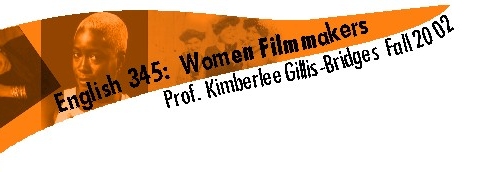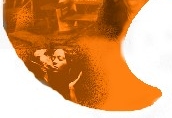


| Course M, 2:30-5:20 W, 2:30-4:20 Thomson 125 |
| Instructor K. Gillis-Bridges Padelford A305 543-4892 MW, 1:00-2:20 |
| Page last updated 12/10/02 |

Assignment
For the presentation, students will work together to conduct research and develop a 20-minute lecture on the historical, cultural or industrial conditions that influenced a particular film, controversies over a director or her work, the director’s characterization of her films, contemporary responses to a film, or recent critical discussions of the director or her work. Groups must read a minimum of three sources for the presentation, two of which should be books, book chapters, or articles. Presenters may use articles in the course packet toward this total.
Presenters should use visual aids (film clips, PowerPoint, transparencies, handouts) to structure their remarks or illustrate points. They should also conclude the presentation with two or three questions for class discussion.
After the presentation, each group member will submit a typed one- to two-page memo briefly describing his or her contribution to the presentation, listing the sources used in the presentation, and explaining how the information presented is essential to our understanding of the director and her work . Memos are due in class on the Monday following the group’s presentation.
Remember that you may do only one presentation as an optional assignment.
Group Presentation Guidelines
In the group presentation, each presenter should speak for an equal amount of time. Groups will be graded on focus, organization, coherence, evidence, completeness, and delivery. When preparing your presentation, keep the following guidelines in mind.
- Focus the presentation. While your research will give you insight into the director, her films, and the contexts surrounding her work, you cannot address all of these areas during the allotted presentation time. Instead, ask yourself which topic will contribute the most to the class’s understanding of the director and her work. What questions, issues, or arguments recur in books and articles written about the director or her films? What topics do course readings cover superficially or not at all? What aspects of your research reveal connections between the director you’re focusing on and other directors studied in the class?
- Connect the information you gather from research to the director and/or film under study. Do not simply summarize each one of your sources in turn. Rather, you should make an argument about the director, her films, or the contexts surrounding her work, using your research to give background and support for your claims.
- Remember your audience. What do they already know about the topic(s) you’re addressing? What terms might they be unfamiliar with? Which points are they likely to understand immediately? Which will you have to explain in more depth? What issues or questions will interest them?
- Make the presentation easy to follow. Use an organizational format suited for oral presentations: chronological ordering, cause/effect, compare/contrast, problem/solution, or most significant to least significant argument. Use transition phrases to signal the shift from one point to the next.
- Cite sources clearly. When you summarize, paraphrase, or quote sources, use signal phrases such as "Waldman persuasively argues" or "as Rich notes."
- Provide visual aids. Clips from the films, Power Point slides, an outline of your presentation, and quotes from applicable sources will help your audience to follow your points. Our classroom is equipped with a VCR, a DVD player, and two overhead projectors.
- Coordinate the presentation with your partner. Each group member should know what other will cover and when he or she will cover it.
- Speak slowly and loudly. Your audience only has one chance to hear your presentation.
- Speak from notes. Although you may worry that nervousness will erase your memory, do not write out everything you plan to say on paper or on your visual aids. Speakers who do so tend to look only at their Power Point slides or papers instead of their audience.
- Avoid lacing your speech with "um," "uh," "like," and "you know." Do not perform the shifty-footed, hand-wringing dance of the terrified orator.
- Conclude effectively. End with a statement that leaves the audience with a final impression of your argument, thank the audience for their attention, or introduce questions for discussion. Do not say "that’s all" or "we’re done." These statements diminish everything you have said.
- Be prepared for questions. Write a list of questions your audience will likely ask. Better yet, practice in front of friends and have them ask you questions.
- Cheryl Dunye
Cristina Brendicke and Jamie Chi's presentation on Cheryl Dunye, the "Dunyementary" and The Watermelon Woman. - Harlem Riots: Students authored this presentation for a course on the Harlem Renaissance. The Power Point slides illustrate how the presenters connected the context of the Harlem Riots to the literary movement of the Harlem Renaissance. The pentultimate slide encourages class discussion by questioning whether the Riots marked the end of the Renaissance and reviewing support for positive and negative answers. Because slides provide only an outline, they don't reproduce the articles from which the presenters read as they discussed the riots; the articles were authored by writers studied in the course.
- U.S.
Film/U.S. Culture Presentations
The following presentations were done for a class on U.S. film and U.S. culture. All relate historical, social, political, and industrial contexts to a particular film. All contain discussion questions for the class.
- Double
Indemnity: This presentation addresses links between film noir
and the post-WWII context as it offers an analysis of Double
Indemnity.
- Hollywood
and HUAC: The presentation discusses the relationship between the
House Unamerican Activities Committee's investigation of Hollywood and
the communism subtext in Invasion of the Body Snatchers.
- The
Movies Go to Washington: This presentation addresses politicians' reception
of and the political contexts surrounding the 1939 film Mr. Smith
Goes to Washington.
I will use this grading scale to evaluate presentations.